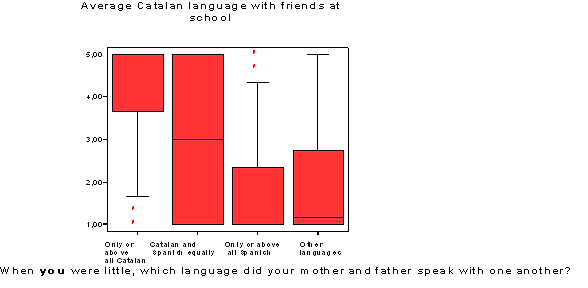 |
En el Gràfic
3 es pot comprovar com els fills de parelles catalanoparlants (primera
columna) utilitzen el català amb els seus amics, mentre que
els fills de parelles castellanoparlants (tercera columna) utilitzen
el castellà. Tot i això, hi ha un percentatge d’alumnes
força visible en els dos grups que no només parla
la llengua dels seus pares, si no que també utilitza l’altra
llengua.
Graph 3. Use of Catalan with friends from school
according to the language spoken between the parents when the pupil
was small

Note: The box graph shows the dispersion
of the values of the dependent variable. Each box consists of a
central horizontal line indicating where the median value is situated
(2nd quartile, at 50%), two red areas (a higher and a lower one)
which, in their limits indicate where the value of the 1st and 2nd
quartiles are (at 25% and 75% of cases respectively) and, finally,
a vertical line (whisker) on each side indicating the distance of
95% of cases. The external points indicate extreme cases.
The multi-variant analysis we present
below attempts to answer the question of which factors are most
related to the maintenance or change of family language in order
to talk to friends? Below we present, firstly, the main elements
interacting with linguistic usages with friends, to place the results
in a general context. Afterwards, we deal with the pupils according
to their initial language in order to go into depth on the different
language usages within the Catalan-speaking group and, then, the
different usages within the Spanish-speaking group. This will help
us to understand the most important circumstances defining usages
tending towards the use of the parents' language or the incorporation
of others.
3.2.
Multivariable analysis of the language spoken with friends
In models with very few variables,
a high capacity for predicting linguistic usages with friends (from
school) has been obtained. The language spoken with brothers and
sisters is the best situated variable and, with this one alone,
an explanation of 49.9% of the variation in language usages with
friends is obtained. The logic is simple, as most pupils who speak
Catalan with their brothers and sisters also use only Catalan with
their friends (51.8%). Moreover, 71% of those speaking Spanish with
all their brothers and sisters also speak only Spanish with their
friends. With this important correspondence between one variable
and another, a very robust model is formed from the very first variable.
But, in order to form a complete model
with the variables needed in order to predict usage in the best
possible way, we select a total of as many as 13 variables. See
them here Table 6. With these, the model is adjusted until 64.8%
of the existing variance is explained. The variables can clearly
be grouped into three sets. The first set, as we saw above, is made
up of the socio-linguistic variables of family origin (presence
of Catalan in interactions with brothers and sisters and parents),
establishing the most important nucleus in order to explain the
presence of Catalan in interactions with friends. Secondly, the
school variables in informal uses and socio-linguistic representations
take over: more informal linguistic uses with teachers (outside
class) and the linguistic reference group ("I'd like to belong
to the group of those who speak...") reinforce the role of
family usages. And finally, in third and last place, the analysis
is completed with a total of nine additional and miscellaneous variables
which obtain much lower correlation indices. These include linguistic
competences, language usages with the teacher in class, linguistic
representations, consumption of communications media in Catalan
or family geographical origin. As we see, these are very diverse
variables which help to complete a good approximation of language
usages with friends.
Table 6. Linear regression model.
Dependent variable: presence of Catalan in language spoken with
friends from school
| R |
R squared |
R squared |
Standard estimation error |
| 0,0809 |
0,654 |
0,648 |
1,00121 |
| |
Standardised coefficients
(beta) |
Significance (standard
error) |
| 1. Language spoken with brothers and
sisters |
-0,214 |
0,000 |
| 2. Language spoken with parents |
-0,202 |
0,000 |
| 3. Language outside class with teachers |
0,146 |
0,000 |
| 4. “I'd like to belong to the
group of those who speak...” |
-0,121 |
0,000 |
| 5. Knowledge of Spanish. Speaking |
-0,094 |
0,000 |
| 6. Pupils' language with the teacher
in class |
0,090 |
0,005 |
| 7. “Catalan is used...” |
0,077 |
0,001 |
| 8. Knowledge of Catalan.
Writing |
0,075 |
0,003 |
| 9. “In your future would you like
to speak Catalan...?” |
0,069 |
0,059 |
| 10. Language of most-listened-to radio
station |
-0,065
|
0,012 |
| 11. Knowledge of English. Speaking |
0,057 |
0,017 |
| 12. Language of the most-watched television
channel |
-0,057 |
0,026 |
| 13. Mother's birthplace |
0,053
|
0,040 |
The general model of the language spoken with
friends prioritises language usages with family members, with
teachers outside class and the linguistic reference group. In
this way it fits the wide variance of linguistic usages with friends
from school.
|
